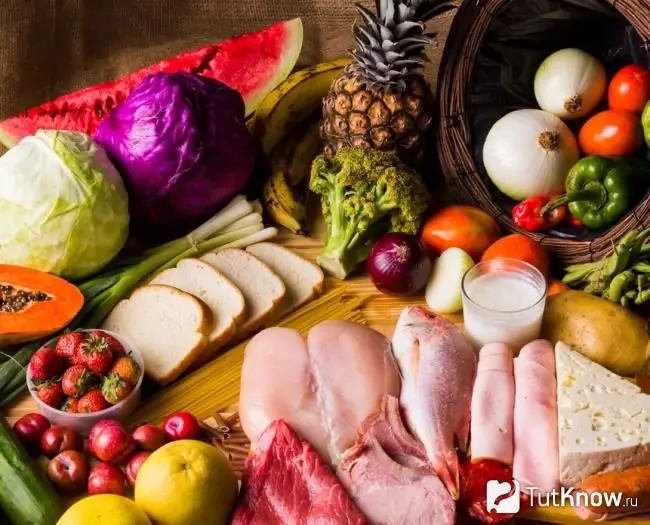- Author Arianna Cook [email protected].
- Public 2023-12-17 14:23.
- Last modified 2025-01-23 09:40.
The rules of the BUCH diet. Permitted and prohibited foods, food ration for every day, for a week and for a month. Results and reviews of those who have lost weight.
The BEACH diet is a protein-carbohydrate alternation, a type of diet that was originally developed for professional athletes. There are more stringent and easier options, and each person will be able to choose the optimal system for himself individually.
Features of the BUCH diet

The basic principle of this type of diet is that it is necessary to limit the consumption of foods rich in simple carbohydrates. When they are absent in the daily diet, the body begins to use first the accumulated glycogen, and then fat as a source of energy. It is very important to consume enough protein on carbohydrate-free days so that the process of burning muscle cells does not start. The main task of such a diet is to quickly normalize weight by burning excess fat.
The BUCH diet can be used for both temporary and permanent compliance. The methodology is based on the principle of periodization when using certain categories of products. Some people use this type of food not so much for weight loss, so much for "drying" the body, in order to give it more relief. The diet helps to cope with a small amount of fat that is located above well-developed muscles.
To achieve the best result, it is necessary to adhere to the following basic principles of the BUCH diet:
- eliminate carbohydrates on some days to ensure an energy deficit;
- reduce the concentration of glycogen, artificially creating a deficiency state;
- with a decrease in carbohydrates, be sure to supplement the diet with a sufficient amount of protein to maintain muscle mass;
- in order to get positive results before and after the BUCH diet, it is necessary to periodically consume food rich in carbohydrates so that the body does not completely slow down all metabolic processes.
If there are difficulties in adhering to the diet, it is necessary to constantly alternate the permitted foods and give preference to moderate physical activity.
The main benefits of the BUCH diet:
- no need to count calories;
- this type of diet is well compatible with physical activity;
- does not affect muscle mass;
- body weight does not decrease too sharply.
Disadvantages of the BUCH diet:
- this type of diet is not suitable for people with obesity, varicose veins, metabolic disorders, as well as for pregnant and lactating women;
- due to insufficient amount of fiber in the diet, complaints of constipation often occur;
- in the process of dieting, it is necessary to visit the gym regularly to improve and maintain the result, which is not suitable for all people;
- in some cases, the pendulum effect occurs: days alternate when the body loses and gains weight. If the calorie content of the carbohydrate day is exceeded, the weight can not only return, but also increase.
If it is not possible to visit the gym, it is recommended to walk in the fresh air every day, at a fast pace - at least 10,000 steps a day.
Allowed and prohibited foods on the BUCH diet

Steamed, boiled, baked dishes are preferred. It is allowed to add a small amount of pink Himalayan salt, Provencal, fragrant herbs.
Allowed foods for the BUCH diet:
- Sources of protein … Products based on casein (goat's milk) that provide long-lasting satiety: lean poultry, egg whites (no yolks), and whey and milk proteins from dairy products with a low percentage of fat.
- Sources of carbohydrates … On unloading days, the use of complex carbohydrates (whole grains) in combination with a small amount of fructose (berries) is recommended. Preference is given to rice, millet, oatmeal (not flakes!), As well as other cereals with a low glycemic index.
- Sources of fats … Fatty sea fish, olive oil for salad dressing as sources of valuable unsaturated fatty acids.
It is also allowed to eat green vegetables, leafy greens, foods high in dietary fiber.
During the BUCH diet, it is recommended to stop eating such food:
- fermented milk products with a high percentage of fat: cheese, curd mass, yogurt, fermented baked milk, sour cream, kefir;
- purchased and homemade sweets, pastries, sweets,
- sauces and marinades, especially commercial foods high in fat and sugar;
- overly sweet berries, fruits, for example, bananas, grapes, figs, commercial sweets based on sweeteners;
- vegetables high in starch and sugar - potatoes, corn, beets;
- alcohol;
- sweet carbonated water, compotes, fruit drinks, smoothies with a high sugar and fructose content.
Particular attention is paid to the way food is prepared. It is contraindicated to eat excessively fatty, fried, spicy foods.






